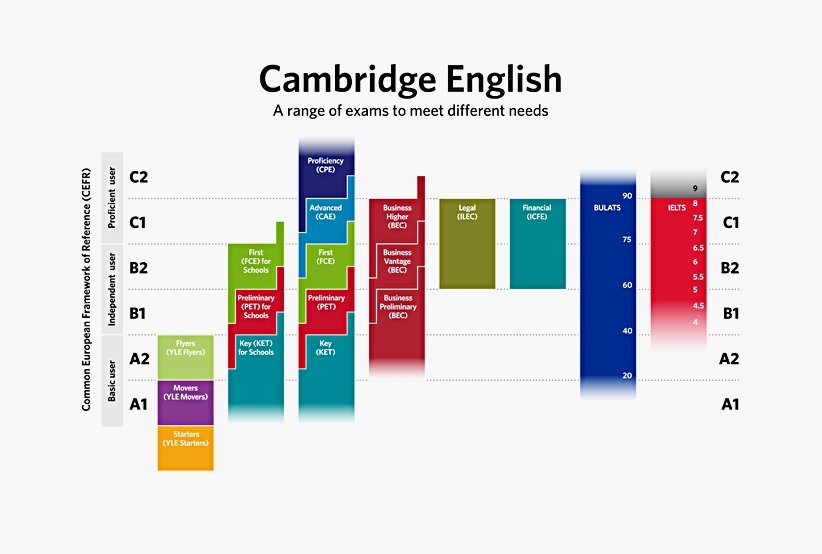When it comes to English language proficiency, two of the most widely recognized frameworks for evaluating your skills are the Common European Framework of Reference for Languages (CEFR) and the International English Language Testing System (IELTS). Understanding the relationship between these two systems is essential for learners, as many institutions and employers require specific scores in both CEFR and IELTS to determine language proficiency.
In this blog post, we’ll break down the comparison between CEFR levels and IELTS scores, helping you understand how the two systems correspond to each other.
What is the CEFR?
The CEFR is a standardized framework used globally to measure and describe language proficiency across six levels, from A1 (beginner) to C2 (proficient). The CEFR is widely used in Europe but has become an international standard for evaluating language skills in many contexts, including education, employment, and migration.
The six levels of CEFR are:
- A1 – Beginner
- A2 – Elementary
- B1 – Intermediate
- B2 – Upper-intermediate
- C1 – Advanced
- C2 – Proficient
Each level reflects different abilities in listening, speaking, reading, and writing in the English language.
What is the IELTS?
The IELTS is one of the most popular and widely accepted English language proficiency tests in the world. It is often required for university admissions, immigration, and employment purposes in English-speaking countries. The IELTS measures language proficiency on a scale of 0 to 9, with 9 being the highest score and 0 indicating no proficiency.
IELTS scores are often broken down into the following bands:
- Band 9 – Expert user
- Band 8 – Very good user
- Band 7 – Good user
- Band 6 – Competent user
- Band 5 – Modest user
- Band 4 – Limited user
- Band 3 – Extremely limited user
- Band 2 – Intermittent user
- Band 1 – Non-user
- Band 0 – No assessable information
How CEFR and IELTS Scores Compare
Below is a detailed comparison of CEFR levels and corresponding IELTS scores. This will help you understand what IELTS band score corresponds to your CEFR level.
| CEFR Level | IELTS Band Score |
|---|---|
| A1 (Beginner) | 3.0 – 3.5 |
| A2 (Elementary) | 3.5 – 4.5 |
| B1 (Intermediate) | 4.5 – 5.5 |
| B2 (Upper Intermediate) | 5.5 – 6.5 |
| C1 (Advanced) | 6.5 – 7.5 |
| C2 (Proficient) | 7.5 – 9.0 |
A1 – Beginner (IELTS 3.0 – 3.5)
At the A1 level, a learner can understand and use basic everyday expressions. They can introduce themselves and ask and answer simple questions. An IELTS score between 3.0 and 3.5 typically indicates a beginner level of English.
A2 – Elementary (IELTS 3.5 – 4.5)
An A2 level user can handle simple tasks and communicate in familiar situations. At this stage, learners can understand basic phrases and frequently used expressions. An IELTS score between 3.5 and 4.5 represents an elementary understanding of English.
B1 – Intermediate (IELTS 4.5 – 5.5)
A B1 learner can deal with most situations while traveling and express personal opinions on familiar topics. They can understand texts on familiar matters. IELTS scores of 4.5 to 5.5 indicate an intermediate proficiency in English.
B2 – Upper Intermediate (IELTS 5.5 – 6.5)
At the B2 level, learners can interact with native speakers without too much difficulty. They can produce clear, detailed text on a wide range of subjects. A B2 level corresponds to IELTS scores between 5.5 and 6.5.
C1 – Advanced (IELTS 6.5 – 7.5)
A C1 learner can express themselves fluently and spontaneously, with a high degree of precision. They can understand complex texts and produce well-organized written material. A score between 6.5 and 7.5 on the IELTS generally indicates advanced English proficiency.
C2 – Proficient (IELTS 7.5 – 9.0)
At the C2 level, learners have near-native proficiency. They can understand almost everything they read or hear and express themselves fluently without searching for words. A C2 level typically aligns with an IELTS score of 7.5 to 9.0.
Why the Comparison Matters
Understanding how CEFR levels and IELTS scores compare is crucial for several reasons:
- University Admissions: Many universities around the world, especially in English-speaking countries, require a specific IELTS band score for admission. Knowing the CEFR level equivalent to the required IELTS score can help students set clear goals.
- Career Opportunities: Many employers require proof of a certain level of English proficiency. Knowing the CEFR level that matches your IELTS score can help you demonstrate your ability to communicate effectively in English.
- Immigration and Visas: Some countries, including the UK, Australia, and Canada, use the IELTS to assess your language ability for visa applications. Understanding where your IELTS score fits on the CEFR scale is vital for meeting immigration requirements.
Conclusion
The CEFR and IELTS are two of the most recognized frameworks for measuring language proficiency. While they use different scales, understanding how they correspond helps learners set clear goals and track their progress. If you’re preparing for an IELTS exam or need to assess your English level for academic, professional, or immigration purposes, knowing your CEFR equivalent can guide your study and test preparation effectively.
Remember, achieving a high score on the IELTS requires dedication and practice. Use the comparison table as a reference to track your progress, and aim for the CEFR level that aligns with your goals!




